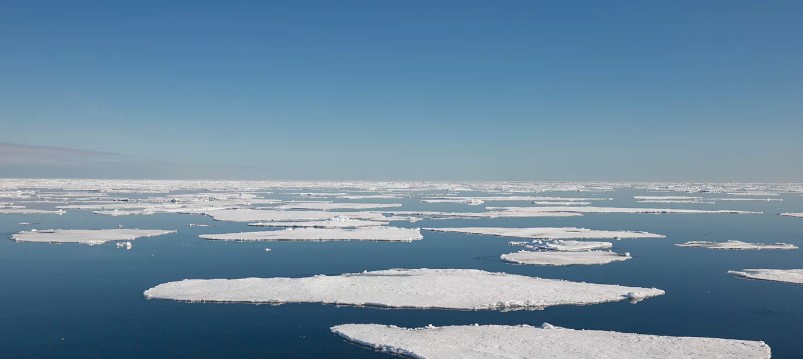
5. Arctic has abundant natural resources
The Arctic has many natural resources, including minerals, that can be highly profitable to humankind. It is said to have vast reserves of natural gas and oil, iron ore, nickel, copper, zinc phosphates, precious metals, gemstones and diamonds. While these are abundant, there is a need for expanding operations to increase production.
It is also rich in fisheries, and since 2011 about eight metric tons have been harvested in Arctic waters.
Rock, stone, sand and gravel are mined in the Arctic region for offshore construction projects. With increasing development in the region, the procurement of these materials is also estimated to increase.
Interestingly, a political dead zone near the Arctic Sea’s centre is related to a dispute among some countries in the region. This is because it might have 25% or more of the undiscovered oil and natural gas.
6. Arctic Ocean experiences a polar climate
Winter in the Arctic is characterised by the polar night, cold and stable weather, including clear skies, offering a sight to behold. However, the sea temperature is quite constant throughout the year and is only -2 degrees celsius.
Since the Arctic Ocean has a saltwater, the temperatures must go to -1.8 degrees Celsius before it can freeze in winter.
Most of the Arctic’s ice pack is layered with snow for around ten months, and the maximum snow cover is in March and April. The climate has changed significantly, and the Arctic Ocean has become warm enough to support tropical life.
Winter starts in September and lasts till May. The ice packs are impacted by the ocean and wind currents.
However, the Arctic ice is melting due to increasing ocean temperatures and global warming. More ice melts in summer, and less water is freezing during the cold months.
Despite the harsh weather, many people visit the Arctic. Most travel starts from Svalbard island, Norway and also Nuuk, Greenland.
7. Has a cool underwater ridge called the Lomonosov Ridge
The Arctic Ocean has an underwater ridge called the Lomonosov that divides the North Polar Basin into 2 oceanic basins, the Eurasian basin that is 4000 to 4500 m deep. The other one is the Amerasian/ North American or Hyperborean Basin, which is 4000 m deep.
The ocean bottom also has many plains, ocean deeps, basins, block ridges and faults. The deepest point of the Arctic Ocean is Molloy Hole which is situated in the Fram Strait at 5550 metres. This is a frigid trench which is nearly rectangular and is also active seismically. It lies 274 km west of Svalbard in Norway.
Victor Vescovo was the first and, till now, the only person to reach the Molloy Deep’s button. He achieved it on 24th August 2019. The leader of the Five Deeps Expedition, Vescovo, descended into the Deep and estimated its depth.
8. Arctic is home to polar bears, which are not found anywhere else in the world
Polar bears are one of the biggest land predators found only in the Arctic. They are categorised as hypercarnivores due to their diet, which consists largely of meat. They have a thick fur layer and a layer of fat that protects them from the extreme cold on land and sea. Their favourite prey is seals, and polar bears can be seen at sea in summer, searching for ice to hunt seals.
Their cubs are born in dens during winter. Sadly, polar bears are threatened with extinction due to rising temperatures in the Arctic which might lead to melting ice caps and glaciers. They are found all along the Arctic Ocean, in Alaska, Canada, parts of Russia, Norway and Greenland.
9. Arctic Ocean is rich in marine biodiversity, especially fish species
The Arctic region has a fragile ecosystem impacted by global warming. The Arctic has walruses and four species of whales, including the grey whale, beluga, bowhead whale and narwhal. Also, six species of seals, including the ribbon seal, ringed seal, harp seal, hooded seal and bearded seal, are found in the waters of the Arctic.
The Arctic also has sponges and sea anemones which feed the bottom-dwelling fish. Additionally, the explorers have discovered more fish species here than anywhere else.
Lion’s mane jellyfish are also found in abundance in the Arctic waters. Also, banded gunnel is the only gunnel species found in the Arctic Ocean.
It has almost no plants apart from the phytoplankton. They are an important part of the Arctic and feed on the nutrients from rivers and the oceanic currents from the Atlantic and the Pacific.
In summer, the sun shines during the day and night, allowing the phytoplankton to photosynthesise for longer. The opposite happens in winter when it struggles to get sunlight to survive in the harsh Arctic region.
10. There are many ports and harbours in the Arctic Ocean
The Arctic Ocean is mostly covered with ice. It does not have many ports because of the harsh weather conditions. The ports transport essential items to sparsely populated communities, handling research and extracting resources.
Some major ports of the Arctic include the Murmansk port of Russia. It lies in Kola Bay in the Barents Sea. It is a major facility handling oil, coal and other items while serving as a naval base as well.
Kirkines port is a major port which connects Norway, Finland and Russia. It is a deep water facility that is ice-free throughout the year, which makes it essential for shipping and fishing.
Another important port is Churchill, a deep water port that remains ice-free all year round for many months. It ships grains, oil and other items.
Russia’s Tiksi port is another crucial port for shipping goods to and from the Russian Arctic.
*Concluded
Follow us on Facebook/ twitter














